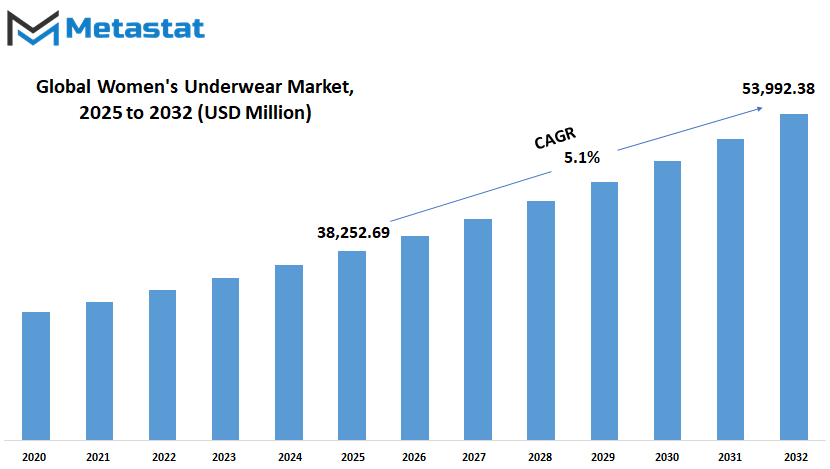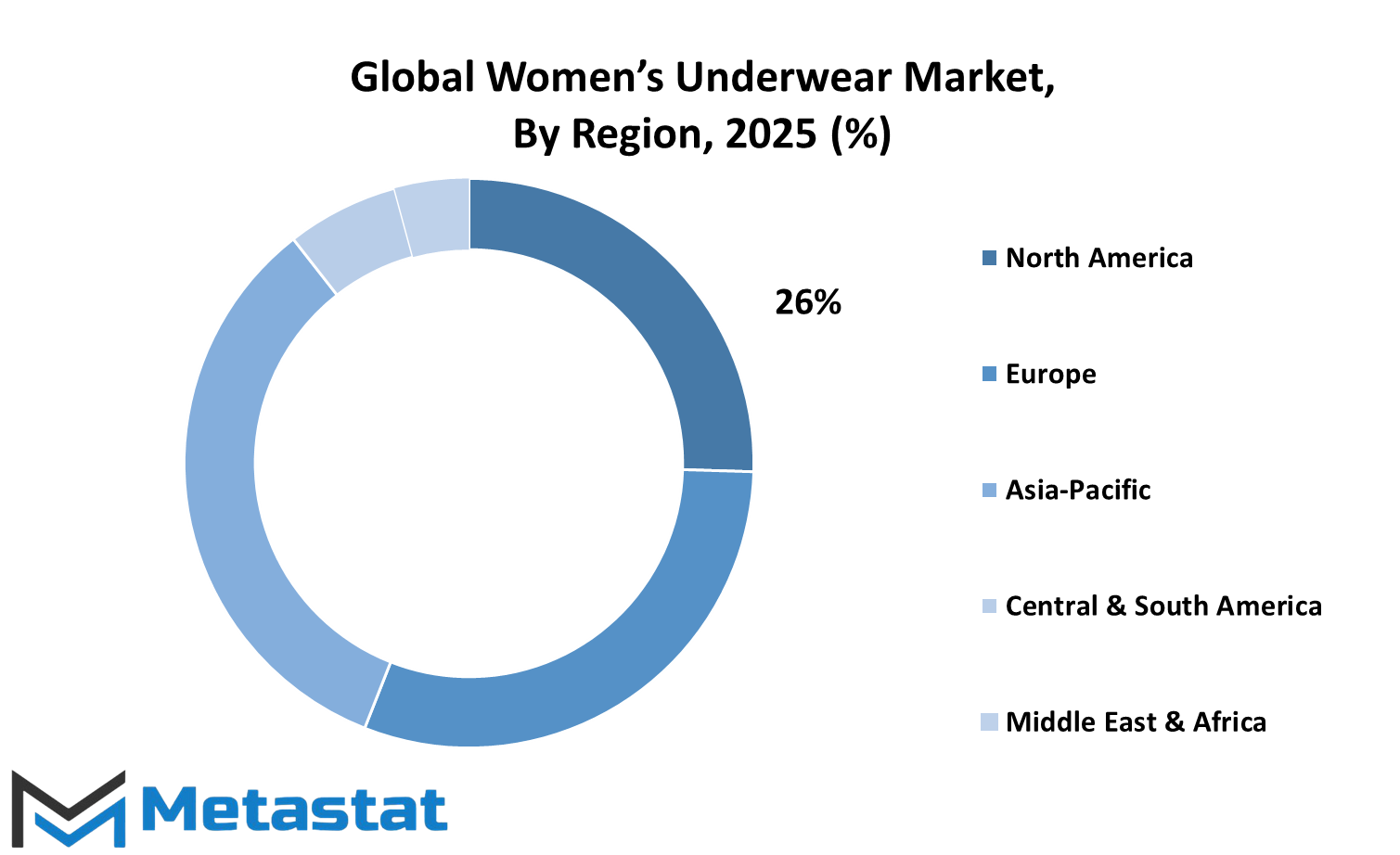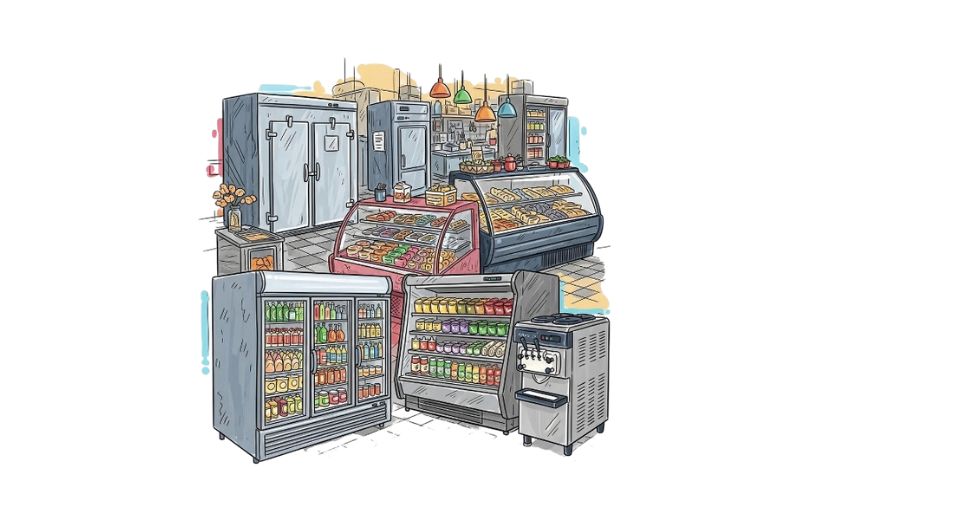MARKET OVERVIEW
The global women's underwear market is large and vibrant, playing an elementary role in the overall apparel sector. It provides a huge variety of products that are designed to be beautiful as well as functional for women belonging to various socio-economic segments. This diversity has widened from being purely utilitarian, every-day items to more premium and luxury brands catering to changing consumer taste, technology, and culture.
The global women's underwear market in essence caters to a wide range of consumers with different tastes, purchasing power, and cultural relevance. The products range from standard undergarments, such as bras, panties, and shapewear, to more specialized ones, such as maternity and sports underwear. All of them serve particular roles in the market, depending on the consumers' desire for comfort, functionality, and fashion. Companies and brands work in a highly competitive ecosystem and keep innovating in a bid to be in a position to differentiate their products and gain loyalty from the customer base. Decades to come will continue to see more and more trends of technological integration and material innovation in the global women's underwear market.
Seamless sewing technologies, sustainable materials, and advanced moisture-wicking technology will define product standards for environmentally friendly and health-conscious consumers. Online stores would also be the primary influencer in the way such products will be marketed and sold. Virtual fitting rooms, an enhanced size-inclusive product line, and AI-powered personalization would have a consumer well-informed before making a purchase, making convenience more core.
The global women's underwear market would remain a mosaic of colorful cultural and regional flavors. In mature economies like North America and Europe, premium and luxury products will emphasize craftsmanship and exclusivity. Emerging markets in Asia-Pacific, Latin America, and some parts of Africa will witness significant growth due to increased urbanization and rising disposable incomes.
These areas will see an upsurge in mid-range to budget-friendly choices with comfort and durability as a more emphasis. Branding and customer engagement will be an important consideration in the formation of the global women's underwear market. Social media will also play an important role in deciding purchases because the youth are attracted towards those brands which are pertinent to them and resonate their beliefs. Transparency in marketing, campaigns, and influencer interaction will help further create the brand voice. This will bring even the smaller, niche brands into competition with biggies, thus making the entire market larger in size.
Besides product innovation, sustainability will be another major thrust area in the global women's underwear market. Ethical sourcing, low environmental impact, and biodegradable usage of materials will find their way into manufacturing processes. Circular fashion initiatives will also come first with businesses focusing on recycling and resale to respond to the growing need for eco-friendly measures. As an integral component of the fashion world, the global women's underwear industry continues to evolve in response to shifting consumer demands. The future would be a mix of the state-of-the-art technology in this genre and cultural and regional differences from consumers who are adopting multifaceted values about this type of product.
Global women's underwear market is estimated to reach $53,992.38 Million by 2032; growing at a CAGR of 5.1% from 2025 to 2032.

GROWTH FACTORS
The global women's underwear market is also expanding considerably, and the expansion is driven by a number of major factors. Primarily, the expansion arises from the growing demand for comfort and usability in their day-to-day wear. Individuals with more hectic and active lifestyles are putting emphasis on comfort and convenience in such products. Shoppers demand underwear that could either keep pace with long work hours or grueling exercises, placing pressure on the industry to devise new innovative strategies in employing mixed fabrics and design inputs to develop new materials with enhanced breathable, moisture-wicking comfort.
Conversely, body positivity and diversity in the fashion sector are on the rise, and this is affecting the global women's underwear market to a large degree. Today's woman wishes to discover styles that complement all body types and sizes, and the market has geared up with more options in the same. This revolution has brought about varied sizing and styles to ensure everyone gets a chance to seek underwear with proper fit and comfort. The growth in body positivity has not only made markets more inclusive but also presented a challenge to conventional beauty perceptions that ultimately empower women. Nevertheless, despite the positive trends existing, there are also possible challenges that could impact its growth. In an era where brands are competing to survive and remain competitive, the need for ongoing innovation is now of greater significance.
The companies need to constantly discover new designs that are innovative and unique enough to attract buyers and make an impact in such a saturated market. The rising supply chain problems and the escalating production cost are a challenge since these might affect the price and supply of goods. Businesses should be capable of transforming extremely fast to the evolving variables and seek means of streamlining their operations to stay alive in this system. Of course, the good growth factor is that consumers become more and more environmentally conscious, thus creating new opportunities for growth in the future.
The more concerned people get about the environment, the greater the demand for sustainable and ethically produced fabrics, as well as green packaging. This change in consumer behavior will propel the requirement for more sustainable practices from companies, and this will be a great opportunity for growth for the global women's underwear market. In the future, companies which are able to balance innovation with sustainability will probably be at the vanguard of the market.
MARKET SEGMENTATION
By Type
The global women's underwear market is expected to experience remarkable growth in the coming years with the onset of shifting fashion trends, awareness among consumers and improved technologies employed in the production of this product. This market has been regarded as diversified owing to extensive product types for meeting varied needs and preferences. On the basis of type, it can be categorized commonly under Bras, Underpants, Sleepwear & Home wear, Shapewear, and others that are bound to see growth and development with time. Bras, a part of women's wear forever, are bound to rule the market even more.
As fashion and comfort are being given more importance, innovations like wireless bras, sports bras, and adjustable bras are fast becoming the new trend. This is likely to increase with time as women prefer their undergarments to be of both use: functionality and fashion. Also, with increased focus on sustainability, the green materials will play a major role in the bra segment, offering a more environmentally friendly option over the conventional fabric options. Underpants, the other inclusion of the women's undergarments market, will also experience the same innovation. The call for comfortable, breathable, and long-lasting underpants will keep on increasing.
As consumers turn towards organic materials and ethically produced apparel, brands are bound to follow suit by creating multiple options in terms of design and fabric composition. The future for underpants in the market will be one of versatility, not only providing comfort but also stylish designs for various preferences. A new category of women's underwear, sleepwear & homewear is observed to have excellent growth opportunities. It is becoming a part of the extension of daily fashion. As more and more women become interested in stylish as well as comfortable loungewear, the demand for sophisticated sleepwear will increase.
Advances in fabric technology in the near future- such as moisture-wicking and temperature-regulating fabrics-will also assist in increasing this segment. Sleep and homewear will coincide with casual apparel in all likelihood, thereby enabling such products to be as versatile for both daytime and nighttime use. Another up-and-coming category is shapewear. The women who want to feel more confident and perfect body shape turn to it.
Shapewear will keep evolving as it follows the trends of designing and material to provide comfort and support products that have become popular. More seamless and lightweight choices providing support without affecting comfort are what can be expected, concentrating on designing shapewear that can be worn for all day long without discomfort. The "Others" segment will consist of niche products that are customized to particular requirements, such as maternity briefs, period underwear, and adaptive wear. These are present-day smaller-sized market shares but will become far more significant going forward since they cater to the needs of women from all walks of life.
Since the global women's underwear market is projected to grow, the product categories will grow even more sophisticated and consumer-driven. Comfort, fashion, and sustainability will be required from products, led by the influence of technology and innovative fabrics.
By Distribution
The global women's underwear market is rapidly booming and evolving, with all elements affecting its growth. Since the market for women's intimate wears is picking up pace, modes through which such products are marketed are evolving to ensure that ever-altering needs and shopping culture of their customers can be addressed in the right manner. These channels of distribution are specialty stores, supermarkets, online sales, and others; and each of them plays the role required for the effective creation of the entire picture of this market. Specialty stores have been one of the most significant channels of retail where women's underwear could be bought for many years.
Specialty stores historically specialize in lingerie with a wide range and considerable counsel to help customers choose the proper garment and style. In the not-too-distant future, specialty stores should be able to find ways to make more of an emphasis on customized shopping with cutting-edge technology. For instance, changing rooms will be used with augmented reality to provide customers with the virtual try-on experience of garments. The companies can also adopt more sustainable practices with the launch of green product lines and using green packaging strategies, which increasingly conscious consumers will endorse.
On the one side, it continues to be a convenient choice for the consumers, but, nonetheless, women's underwear had continued to be a rare commodity there, and now, supermarkets, as they roll out their lines of products, will surely roll out this line of intimate wear.
This could be driven by a need for convenience and by the necessity to shop in one location for all their everyday needs. As supermarkets keep improving their private-label lines, we can expect even more aggressive pricing and emphasis on affordability. Internet sales is rapidly becoming one of the most powerful channels of distribution for women's undergarments. The convenience of shopping from home, combined with vast choices and the ease to compare prices, renders this method of shopping extremely appealing to most. In the immediate future, consumers' use of artificial intelligence and virtual assistants in the marketplace will continue evolving, enabling them to make informed buying decisions about their options according to their tastes and past behaviors in shopping.
Moreover, expansion of subscription services and direct-to-consumer brands will further revolutionize how women buy intimate apparel through convenience and personalized experiences. Other channels, including direct selling and vending machines, could become more significant as firms seek alternative ways to reach customers. With advances in technology and changing patterns of consumer behavior, these channels will play an increasingly larger role in defining the future of the global women's underwear market. Overall, the industry will adapt to new trends and innovations, offering a more personalized and convenient shopping experience to meet the diverse needs of women worldwide.
|
Forecast Period |
2025-2032 |
|
Market Size in 2025 |
$38,252.69 million |
|
Market Size by 2032 |
$53,992.38 Million |
|
Growth Rate from 2025 to 2032 |
5.1% |
|
Base Year |
2024 |
|
Regions Covered |
North America, Europe, Asia-Pacific Green, South America, Middle East & Africa |
REGIONAL ANALYSIS
The global women's underwear market is fast expanding and diversifying in accordance with transforming consumer attitudes and evolving social trends. Regional disparities have a great influence on the dynamics of this market in terms of shaping product demand, production patterns, and overall growth. From a geographical point of view, the study of the market offers meaningful insights into how cultural, economic, and lifestyle factors contribute to its growth.
North America provides an excellent market, as it has high purchasing power and awareness of personal comfort and health. The United States is in the lead here, with its innovative designs and premium brands appealing to a broad range of population. Canada and Mexico are also on the rise but could lean towards affordability and functionality. In Europe, markets such as the UK, Germany, France, and Italy are high demand in terms of luxury and sustainability. European consumers favor environmentally friendly materials and ethical production, pushing brands to experiment with organic materials and conscious manufacturing approaches.
Asia-Pacific, being one of the fastest-growing markets in the global women's underwear market, reflects a vibrant mix of ancient tradition and cutting-edge modernity. Higher urbanization in the likes of India and China, as well as wider influences of international fashion trends, are further boosting demand for various styles and lower price points. Conversely, Japan and South Korea emphasize innovation and quality since consumers are looking for technologically high-end fabrics and distinct designs. The region's middle class and its growing retail networks offer fantastic opportunities for both global and local brands. South America, particularly Brazil and Argentina, is a more cultural identity-based market where tastes for underwear are color and pattern-oriented since consumers like colors and patterns more in indigenous fashion.
This market is also expanding due to increased awareness of quality products that is being created as a result of enhanced visibility of global brands. Norms in culture play an important role in shaping market trends in the Middle East and Africa. Nations such as those in the Gulf Cooperation Council, Egypt, and South Africa are defined by growing appetite for moderate but stylish products that combine tradition with modern trends. The economies in these areas are still unleashing more growth prospects, most of which are in cities. Regions markets, in the short term would experience much more technical harmonization by means of smart textiles as well as customization for all regional requirements. Sustainability, lastly, and inclusion with each brand would endeavor to develop a more universal consumption environment that will align towards their global demand expectation across cultures. The global women's underwear market is going to continue to remain dynamic but really pluralistic to respond to those regional diversities.

COMPETITIVE PLAYERS
The global women's underwear market has witnessed high growth based on the changing needs and preferences of the consumer. The growth in this market is driven by various factors, including a shift in lifestyle patterns, a growing emphasis on comfort and sustainability, and technology innovation in fabric and design. Competitive gamers would drive a major part of defining the trajectory of this market, which is further becoming competitive as the established brands as well as new brands keep competing to claim a larger portion of consumer Mindspace.
Top brands like Aimer, American Eagle (Aerie), and Victoria's Secret continue to innovate to meet the needs of today's consumers. Brands like Triumph International and Calvin Klein, which are famous for their classic appeal, are further developing their product lines with the addition of designs that focus on functionality in addition to style. This trend indicates a better comprehension of consumer needs with more women placing an importance on practicality without affecting beauty.
Technology has also begun to influence the landscape of the global women's underwear market tremendously. Innovative fabric technologies, such as moisture-wicking fabrics and seamless constructions, have changed classic offerings. Regina Miracle Intimate Apparel and Ubras are leading the way with innovative manufacturing methods. These developments not only increase comfort but also ensure longevity, attracting a wider audience.
There is presently sustainability as the driving force imperative in the market. Hanes Brands and Marks & Spencer are only a few of those that have taken on ecologic practice with demand increasing for responsible environmental products. The applications of organic cotton to water-conserving manufacturing practices, for instance, resonate vividly with the environmentally conscious consumers, which are presently changing trends in purchase activities all over the world.
The future market will witness greater synergy of technology and sustainability. It will be a chance for companies such as Maidenform and Jockey International to incorporate smart textiles in their products. Moreover, companies such as Enamor and Vanity Fair are attempting to be inclusive by offering greater sizes and varieties of products to appeal to all kinds of consumers.
Online stores and e-marketing strategies are also transforming the distribution of these products to consumers. Brands such as UNIQLO and Fruit of the Loom are using online channels to offer greater accessibility and targeted customer experiences. The practice will gain momentum, as online platforms make it easier for brands to target niches.
As consumer needs further develop, competitive forces in the Global Women's Underwear industry will continue to be ahead on innovation, sustainability, and inclusiveness, ensuring it is relevant in an ever-changing environment.
Women's Underwear Market Key Segments:
By Type
- Bras
- Underpants
- Sleepwear & Homewear
- Shapewear
- Others
By Distribution
- Specialty Stores
- Supermarket
- Online Sales
- Others
Key Global Women's Underwear Industry Players
- Aimer
- American Eagle (Aerie)
- Calida
- Calvin Klein
- Debenhams
- Enamor
- Fruit of the Loom
- Hanes Brands
- Hop Lun
- Jockey International
- LaSenza
- Maidenform
- Marks & Spencer
- Regina Miracle Intimate Apparel
- Triumph International
- Ubras
- UNIQLO CO., LTD.
- Van Heusen
- Vanity Fair
- Victoria's Secret
WHAT REPORT PROVIDES
- Full in-depth analysis of the parent Industry
- Important changes in market and its dynamics
- Segmentation details of the market
- Former, on-going, and projected market analysis in terms of volume and value
- Assessment of niche industry developments
- Market share analysis
- Key strategies of major players
- Emerging segments and regional growth potential








 US: +1 3023308252
US: +1 3023308252






